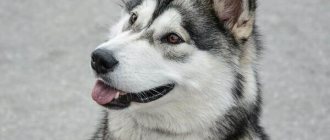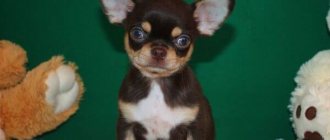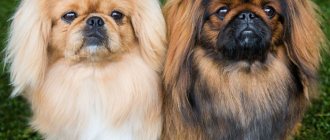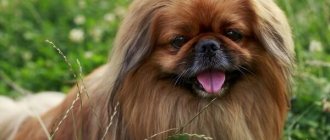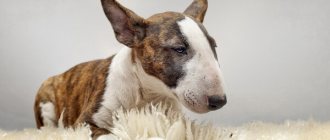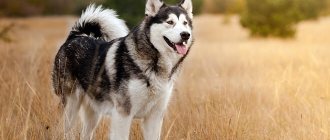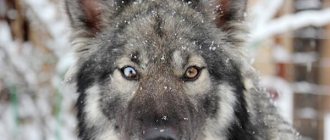03/23/2019 Irina Malinina 3 comments
The Alaskan Malamute is an indigenous dog breed that is rightfully considered very ancient. When you look at these animals, you immediately remember the harsh northern regions, merciless blizzards and blizzards, dog sleds crossing endless snowy plains. And also real male friendship, the hard and often unsuccessful work of gold seekers.
The Alaskan Malamute is so close to the harsh nature that sometimes it is hard to believe that this animal has become a real pet and successfully lives next to humans. After all, the dog's appearance still makes him look like a wolf.
The breed got its name thanks to the tribe, among whom it was very popular. The tribe was called Malemute. The Malamute dog has been in danger of extinction more than once, but was able to survive against all odds. Today the breed is one of the TOP most popular breeds in the world.
Origin story and what it looks like in the photo
There is no exact information about the time of the appearance of the breed, but it is known that Alaskan Malamutes descended from domestic dogs that belonged to the Malamute tribe and were distinguished by power and endurance and had thick and dense hair.
These animals were used for riding and carrying heavy loads.
The so-called “gold rush”, which marked the end of the 19th century, had a significant impact on the development and spread of the breed, since Alaskan Malamute teams were the only way to get to the deposits.
The desire of gold miners to acquire and use these dogs was reflected in the population of the breed.
Active attempts to increase the number of Malamutes and increase their endurance and speed led to interbreed matings , which reduced the number of purebred individuals .
The revival of purebred Malamutes began when sled racing became popular. It was only in the 1920s that the Alaskan Malamute managed to avoid extinction and increase its numbers. 20th century, and in 1935 the breed was officially recognized.
Another difficult period for these dogs was during the Second World War, when their numbers were reduced to no more than 30 individuals..
Thanks to work to restore the breed in the post-war period, the extinction of the Malamute was avoided.
Application
The Alaskan Malamute is a sled dog designed for transporting goods. Puppies begin to be trained as soon as their joints and muscles are formed. Therefore, it is important to know to what age animals grow. They reach the size of adults by 7-8 months. However, it is better to wait up to a year for the bones to finally become stronger.
You can raise a puppy as a hunting assistant. He will work for the beast in deep snow. But he will turn out to be a useless guard. An animal can scare an uninvited guest with only one thing – its large size.
In Russia, Alaskan Malamutes are practically not used for their intended purpose. They are often found by fans of extreme recreation, hiking and cross-country skiing. The pet will be an excellent companion for a person involved in sports.
Interesting Facts
- Representatives of this breed starred in the films “White Captivity” and “Snow Dogs”.
- Alaskan Malamutes are included in the Top 30 popular dog breeds and occupy 18th place in it.
- In 2010, the breed was appointed as the symbol of the American state of Alaska.
- It is the Alaskan Malamutes that are described in the books of Jack London and Rudyard Kipling.
- Representatives of this breed have an unusual paw design - after pressing on the pad, their claws jump forward, like cats.
Puppies
You should think carefully before buying such a puppy - it requires a lot of attention, and thanks to its excessive liveliness, you will have to take long walks with your pet with active games and jogging. In addition, this dog cannot be kept in an apartment if there are people with allergies in the house. If the future owner does not have such an opportunity, it is better to abandon the idea that a Malamute will live in the house.
Choosing a puppy
Before purchasing a small pet, you need to carefully observe all the puppies from the litter - healthy dogs are extremely active, love to play, and do not show aggression. They should not have any discharge from their eyes or nose, and their fur should be fairly shiny and not dull.
It is advisable that the breeder provides all the necessary certificates and pedigree, but in this case the puppy will be expensive, but the buyer will have a guarantee that he is purchasing a healthy vaccinated puppy from elite parents.
Price
A puppy without a pedigree costs about 11,500 rubles, with a pedigree - from 12 to 29 thousand, and elite puppies from champion parents - above 30,000 rubles.
Description and standard according to RKF
Alaskan Malamutes are dogs with a powerful, strong build, a deep chest, but a compact body of a square format.
This is an excellent example of working dogs, but, unfortunately, they are not suitable as guard dogs, since they are completely devoid of aggression.
Representatives of this breed, in accordance with the standard, must have the following traits:
- head wide, but proportional to the body;
- voluminous, non-pointed muzzle;
- triangular, erect, wide-set ears with rounded ends;
- scissor bite;
- small almond-shaped eyes with brown irises;
- black or brown (in red-haired individuals) nose;
- powerful, bear-like paws.
Blue eyes and aggressive behavior are considered abnormal . Serious faults include incorrect positioning of the paws and changes in their shape, excess weight or thinness, imbalance in body proportions, and too long hair.
According to the breed standard, the depth of the chest should be approximately half the height at the withers, and the length of the body should exceed the height of the dog.
NECK, BACK LINE, BODY
The Malamute's neck is strong and moderately arched. The chest is well developed. The body is compact in structure, but not short coupled. The back is straight, slightly sloping towards the hips. The loin is strong and muscular. A long loin can weaken the back and is a disadvantage.
The Malamute's neck should be deep and muscular.
The Malamute's neck should be deep and muscular. It should have a nice curve when viewed from the side and flow smoothly into the shoulders and back. An insufficient angle of the shoulder joint is often the reason that a dog does not have a well-defined neck.
The Malamute's chest is wide and deep. A well-formed chest will not be hollow, narrow or with the elbows close together. The chest should not be so wide that it displaces the elbows and prevents the front legs from reaching properly when moving. The Malamute should not have a barrel-shaped or laterally flat chest, but the chest should be able to expand to meet the oxygen requirement for endurance. The sternum should not be excessively prominent, but should be immediately felt when examining the dog.
Narrow stance, elbows close together, and Chest too wide, elbows out
The line of the back is strong, straight and has only a slight slope from the withers to the sacrum. The tilt should not be too sharp or excessive, which could negatively affect the power of propulsion from the hindquarters when moving. During movement, the line of the back should remain unchanged with no signs of weakness such as swaying of the body, bouncing, sagging or arching of the back. The curvature of the Malamute's tail often causes the hair to rise on the rump, which can give the appearance of a high rear in a dog with a regular topline. It is therefore very important that the judge checks the line of the back with his hands, rather than relying solely on a visual assessment.
Arched back, and Sagging back and long lower back
The standard speaks of a compact Malamute body, but not short coupled. A short lower back may interfere with proper long strides. The loin should be of sufficient length to allow economical movement, but not so long as to weaken the back.
Correct placement and carriage of the tail
The tail is moderately set and continues the line of the back at the base. If the dog is not working, she carries it over her back. The tail should not hang significantly below the line of the back or curl into a tight ring on the back, and it should not be short-haired like a fox's tail. The tail should be well feathered and give the appearance of a waving plume.
Tail hanging to the side, too short and curled into a ring
The Malamute's tail, shaped like a billowing plume, is a distinctive characteristic of the breed. The tail continues the line of the spine, curling freely over the back. It should be well pubescent and of sufficient length to form a curving "fluttering plume". The tail should not curl into a ring, lie on the back or hang to the side significantly below the line of the back. When standing at rest, the Malamute usually hangs its tail down, and when working or moving, it pulls it back.
Character traits
Alaskan Malamutes are friendly and good-natured dogs . Despite their impressive size and rather menacing appearance, they are absolutely not suitable for the role of guards, because they are too sociable and kind, they have no aggression.
This breed needs companionship and constant contact with its pack, whether that be other dogs or the human family. Living alone and in a closed enclosure is not suitable for these dogs; such conditions can even make them sick.
Malamutes become attached to their owner, but it is important for them that he constantly proves his authority and leadership, otherwise they begin to look for these qualities in other people.
These dogs need physical activity; they prefer an active lifestyle full of different experiences. The monotony quickly tires them.
Malamutes are smart and able to quickly remember commands, but due to their natural tendency to dominate, stubbornness, willfulness and dislike of repeating the same actions, they may refuse to carry them out..
That is why it is important to approach the learning process correctly, showing your pet from puppyhood who is the leader in the house. In many cases, it is impossible to do without undergoing OKD from professional dog handlers.
Among the harmful and almost ineradicable habits of Alaskan Malamutes, their love for digging holes, even if they live in city apartments, and their manner of howling at the moon are especially notable.
Expert opinion
Kozhevin Semyon Kirillovich
Expert dog handler.
Alaskan Malamutes are not dogs for beginners. They are by nature stubborn, self-willed and accustomed to dominate; these character flaws can only be smoothed out by proper upbringing. Representatives of this breed are not characterized by aggression, but such behavior can be the result of psychological trauma suffered during puppyhood, errors in education, cruelty of people and a number of other reasons that can instill anger even in such peace-loving animals.
MOVEMENTS
The Malamute's movements are smooth, balanced and powerful. He is quite agile for his size and build.
Correct movements – the Malamute often moves with its tail extended back
The Malamute is a dog that works on the move, often moving over steep, rough terrain, avoiding obstacles in its path and making sharp turns. Therefore, the reliability and endurance of the Malamute's movements is a vital characteristic. His movements must demonstrate strength, and at the same time, agility and tirelessness.
When viewed from the front or rear, the limbs move strictly along the line
When viewed from the side, it is clear that the powerful hind limbs make a strong push, which is transmitted through the muscular lower back to the front ones. The forelimbs receive impulse from the hind limbs and take a smooth, wide step forward. When viewed from the front or rear, the limbs move strictly along a line, neither too close nor too wide apart. When moving at a fast trot, the paws will move closer to the center line located under the body.
The Malamute should move in smooth, long strides with a strong push from the hind legs, the force of which must be transmitted through the lower back to the front legs. This breed is not designed to trot like herding breeds. Straightening of the limbs should be moderate and smooth, without high lifting, slapping with paws or other senselessly wasting energy. Thrusting out the limbs may be impressive to spectators, but it is a wasted and ineffective movement.
The head and neck should be extended forward and the back should remain strong and not arch, sag or rock to maintain a straight line and transmit power during movement. As discussed in the sections on forelimbs and hindlimbs, the forelimbs and hindlimbs should move exactly in the same line, moving closer to the center line as speed increases. If the Malamute's front and hind legs meet the standard requirements, he will not exhibit crab-like movements, excessively extend his limbs upward, exhibit overlapping or intertwining of limbs, or other movement errors.
Movement is the most important factor
Stilted gait or any other type of movement that is not sufficiently productive and/or tireless must be penalized.
Poor angulation of the front and rear legs results in a shortened stride, forcing the dog to take more steps to cover the same distance relative to a properly built dog.
Movement is the most important factor influencing a dog's score when judging the Alaskan Malamute breed. Any deviations from absolutely correct, effortless and effective movements should be seriously penalized.
Advantages and disadvantages
In addition to their bright and attractive appearance, Alaskan Malamutes have a number of other advantages.:
- good-natured disposition;
- friendliness;
- endurance;
- mind;
- love for children;
- no dog smell;
- lack of aggression;
- communication skills.
Along with its advantages, this breed also has disadvantages.:
- tendency to dominate;
- stubbornness;
- lack of protective instincts;
- independence;
- love of digging holes;
- howl.
In addition, these dogs cannot live in isolation or even relative solitude; they need constant contact with other animals or people.
TEMPERAMENT
The Alaskan Malamute is an affectionate, friendly dog, but not a “one-owner” dog. The Malamute is a loyal and devoted companion, playful when invited. Usually, after growing up, the Malamute is especially impressive with its sense of self-esteem.
The Malamute is a true pack animal with a natural instinct to “lead or be led.” This manifests itself in independence, self-confidence and strong willpower, and also explains why the Malamute can at times be aggressive towards dogs of the same sex. Although Malamutes have historically guarded Eskimo settlements and children, they are not the type of guard that perceives eye contact or the approach of a stranger as a threat. Dogs that react negatively to people do not exhibit the typical and correct Malamute temperament. Any sign of Malamute aggression towards people is unacceptable.
Young Malamutes will respond positively to any action that they perceive as an invitation to play, and curiosity may lead them to try to pull off the judge's dangling jewelry, hat or bodice.
Color variations
The color of the coat depends on which within-breed species the individual belongs to.
The coat of Alaskan Malamutes can be:
- black and white;
- gray-white;
- silvery white;
- red and white;
- sable
Representatives of the breed with a uniform coat color can only be white.
Types and brief description
There are 2 intrabreed species of Alaskan Malamutes, which have some exterior differences: M'Loot and Kotzebue.
M'Luth
These dogs grow up to 63 cm at the withers and weigh 38 kg . Despite their powerful bones and large dimensions, these are active animals that are characterized by some aggression.
Their coat can be white, black and white, brown and white, sable, silver blue or red and white.
Kotzebue
Representatives of this species are smaller than M'Lut - their height is no more than 60 cm and their weight is 36 kg . These dogs with wolf coat color are less active, more docile and not prone to aggression.
WOOL
The outer coat (coat) of the Malamute is thick and hard, not long and not soft. The undercoat is dense, dense (filled), 2.5 cm to 5.1 cm (1 to 2 inches) in length, oily and woolly. The outer coat varies in length, as does the undercoat. The coat varies from relatively short to medium along the sides of the body, increasing in length around the shoulders and neck, along the back, over the croup, as well as on the trousers and tail hair (fluffy plume).
The texture and quality of the Malamute's coat was critical to survival in the arctic climate. The double, hard coat with water-repellent properties allowed these dogs to withstand extreme temperatures and difficult environmental conditions. For purposes of determining whether a coat is correct, its texture is key. The oily, padded wool undercoat is 2.5 cm to 5.1 cm (1 to 2 inches) long and is softer to the touch than the topcoat. The length of the outer coat is from 7.6 to 10.2 cm (3-4 inches). It should not be long or soft. The coat is thicker and longer around the neck, along the back, and on the pants and tail area. Bitches may have a slightly shorter coat, but it should not be less dense. Some dogs have more impressive coats than others, but a shorter, dense coat is also correct.
Typically, during the summer months, Malamutes have shorter and less dense coats. The Malamute is exhibited in its natural state. Grooming or trimming of dogs is not permitted, with the exception of paws, which must appear neat.
When a Malamute sheds its winter coat, it has virtually no undercoat left, and the outer coat may lie horizontally. This is normal and should be judged accordingly. Changing the texture of the fur on the body with the help of cosmetics, as well as cutting and trimming any areas other than the paws, is absolutely unacceptable.
Is it suitable for living in an apartment? On the street?
Malamutes are freedom-loving dogs that do not tolerate cramped, enclosed spaces and need space . Representatives of this breed are not suitable for keeping in city apartments and cramped enclosures, and they should not be chained.
The most suitable option is a fenced area of a private house, where the dog can move freely. If a dog lives in an enclosure, it must be spacious and open.
The coat of Malamutes allows them to be kept outdoors throughout the year..
Owner reviews
According to reviews from the owners, if you work with a puppy of this breed constantly from the very beginning, then in the future such a dog will be a faithful, obedient friend who recognizes the leadership of its owner and shows practically no stubbornness.
However, if there are kids in the house, then it is better to hold off on purchasing a Malamute and wait until the children are older.
Attitude towards children and does he get along with other pets?
Malamutes get along well with children; friendships are quickly established between them . At the same time, it is important to ensure that the puppy does not behave aggressively towards the baby even during play.
CAREFULLY!
If a child comes into the family when the dog is already grown, it is necessary to ensure that it does not harm him - a large dog can accidentally hit the baby, frightening or injuring him.
They can get along with other pets if they grew up together. The most difficult relationships for Malamutes are with cats and birds, which they most often pursue as objects of hunting.
Feeding
Special attention should be paid to the issue of feeding your pet. You need to immediately decide on the type of feeding so as not to injure the animal or harm its health. Many people believe that any food that is advertised hourly on TV is better than natural food.
It is not always so. On TV, low-quality feeds that do not contain the necessary components are often praised. You should not feed your pet economy class food. If you are going to make a choice in favor of dry food, then you need to choose those that have a class no lower than premium.
The advantage of natural food is that the owner himself can control its quality. But here you also need to take into account that feeding must be correct and well-balanced.
Veterinarians recommend not mixing dry food with natural food.
Care and maintenance
Caring for representatives of this breed is not too difficult . The main thing is to do this regularly and accustom your pet to all hygiene procedures from an early age.
Wool and bathing
To avoid matting of the coat and the formation of tangles, these dogs must be brushed at least 2 times a week, using combs, combs and slickers that help care not only for the top coat, but also for the undercoat.
During seasonal shedding, your pet needs to be brushed daily..
Malamutes' coat has the ability to clean itself, so you can bathe them no more than once a quarter, using shampoo and conditioner appropriate for their coat type and color.
It is necessary to rinse off the shampoo thoroughly, otherwise it can cause irritation of the skin and mucous membranes . After bathing, dry and comb your dog thoroughly.
Ears
Regularly, once every 1-2 weeks, inspect and clean from accumulated dirt and sulfur using a cotton pad soaked in warm boiled water, and in case of severe contamination, in hydrogen peroxide.
Claws
If the nails do not grind down on their own during walks, they must be trimmed monthly with a guillotine nail clipper designed for large dog breeds.
Teeth
Brush twice a week using a special brush and paste for dogs . You should also give your pet treats and toys that help mechanically clean the teeth of plaque and stones.
Eyes
Wipe weekly with a cotton pad soaked in chamomile infusion or tea leaves.
Caring for an Alaskan Malamute also includes timely vaccinations, treatment for external parasites and deworming..
Life expectancy and major diseases
Alaskan Malamutes have good health.
However, they are prone to such pathologies as:
- diabetes;
- cataract;
- glaucoma;
- autoimmune hemolytic anemia;
- epilepsy;
- bloating;
- chondrodysplasia;
- hip dysplasia;
- hypothyroidism;
- gastric volvulus;
- retinal atrophy;
- hemeralopia;
- polyneuropathy;
- adenocarcinoma of the anus;
- corneal ulceration;
- hemophilia;
- atopic dermatitis;
- demodicosis;
- hypothyroidism
In addition, Alaskan Malamutes may have a condition called “snow nose” (weakened pigmentation), which is characterized by a pink instead of black color on the nose, lips, and eye area.
These pets are prone to sunburn, so care must be taken when taking them out into the open sun.
With proper care and proper housing conditions, Alaskan Malamutes live on average 13-16 years.
Nutritional Features
The number of daily feedings depends on the age of the dog:
- 1.5-2 months – 6 times;
- 2-3 months – 5 times;
- 4-5 months – 4 times;
- 6-7 months – 3 times;
- 1 year and older – 2 times.
These dogs can be fed with natural products and industrial food. Each type of food has pros and cons, so it is impossible to clearly judge which one is better; the choice depends on the owner.
The natural diet should include:
- rice, buckwheat, oatmeal;
- chicken and beef by-products;
- kefir;
- cottage cheese;
- lean sea fish without bones;
- vegetables, fruits, herbs;
- boiled eggs;
- lean meat.
It is forbidden to feed representatives of this breed:
- pickles, smoked meats, marinades;
- sausages, bakery and pasta products;
- corn, legumes;
- fatty meat and fish;
- fried foods.
IMPORTANT!
With a natural diet, it is necessary to additionally give the dog vitamin and mineral supplements.
When choosing industrial feed, you should purchase premium products, or better yet, super-premium or holistic feed. The most suitable foods for these dogs are Royal Canin, Nutra Nuggets, Advance, Brit Care, Nutra Gold, 1st choice, Artemis, Orijen, Grandorf, NOW.
Sample menu for the week
| Day of the week | Food |
| Monday | 500 g beef, 200 g cottage cheese, 200 g rice porridge, 100 g vegetables and herbs, 1 egg |
| Tuesday | 500 g veal, 200 ml kefir, 200 g buckwheat porridge, 100 g vegetables and herbs |
| Wednesday | 600 g fish, 250 g cottage cheese, 150 g rice porridge, 100 g vegetables and herbs |
| Thursday | 250 g beef, 250 g offal, 200 g natural yogurt, 200 g oatmeal, 100 g vegetables and herbs |
| Friday | 500 g beef, 200 g cottage cheese, 200 g rice porridge, 100 g vegetables and herbs, 1 egg |
| Saturday | 600 g fish, 250 g cottage cheese, 150 g rice porridge, 100 g vegetables and herbs |
| Sunday | 250 g chicken, 250 g offal, 200 g natural yogurt, 200 g oatmeal, 100 g vegetables and herbs |
Training and education
| Team | Education |
| To me | When your pet remembers its name, you need to call it by it, saying “Come to me!” When the dog approaches, he should be given a treat |
| Near | The dog should walk at the owner's left foot. To do this, you need to say a command and pull the leash so that the Malamute cannot move to the side or forward. |
| Sit | Pull the leash up and lightly press on the pet's croup, forcing him to sit |
| Ugh | When the puppy does something forbidden, you need to grab him by the withers, shake him slightly and say “Ugh.” |
| Right left | While walking, you need to make turns in different directions. 1-2 m before the turn, you should repeat the “right-right-right” command 3 times, and then make the turn, if necessary, helping the dog with a leash |
| Towing | When the puppy is six months old, you can prepare him for towing training by letting him pull, for example, an empty sled. Representatives of this breed are ready to tow a person no earlier than 1 year. While walking, you need to give the dog the command “Forward” and pull on the leash. |
| Stop | While the dog is moving, it is necessary to loudly say “Stop” and immediately stop, pulling the Malamute with a leash. |
Breeding
In female Malamutes, the first heat occurs at 8-12 months. Then it is repeated every six months. Its duration ranges from 18 to 20 days. At this time, the animal may become disobedient, excitable, and refuse food.
Before breeding dogs, you need to pay attention to the following. Decide what color you want offspring, based on this and select a pair. To avoid incest, analyze the previous 3 generations by pedigree.
Pregnancy of bitches lasts 59-63 days. About 9-10 hours before giving birth, your dog will begin to behave restlessly, this is due to the start of pushing. As a result of childbirth, 5-8 babies appear.
How to choose? Boy or girl?
to purchase a puppy from a specialized nursery - this eliminates the possibility of buying a purebred or sick pet .
It is also important to inspect the living conditions of the dogs, meet the puppy’s parents and find out about their health, since many malamute pathologies are hereditary.
The puppy should have shiny fur without bald patches or traces of dandruff, clean skin without rashes or irritations, pink mucous membranes, clear eyes without signs of increased lacrimation and other pathologies.
The puppy must be active, inquisitive, sociable, aggression is unacceptable.
When choosing between a male and a female, you should remember that girls are more docile and affectionate; some inconveniences in their maintenance are associated only with regular estrus.
Boys are more stubborn and willful, and tend to mark territory . At the same time, if you have plans to participate in breeding the breed, you should buy a female; if you plan to have an exhibition career, you should buy a male.
How much does an Alaskan Malamute cost?
The cost of a Malamute puppy with great exhibition prospects can reach 100 thousand rubles.
Children without documents are valued much cheaper, their price does not exceed 10-15 thousand rubles. Such a significant difference in price is explained by the fact that puppies - potential winners of exhibitions and competitions - are usually used for breeding, producing excellent offspring. But no one has such views on kids without a “passport”; they remain just pets. The cost of Alaskan Malamute puppies is also influenced by the regalia of the parents. The offspring of the titled winner of world exhibitions will cost the most. Puppies from a dog that won the Russian Championship are somewhat cheaper. Well, the lowest price will be for puppies whose parents only have an “excellent” rating.
